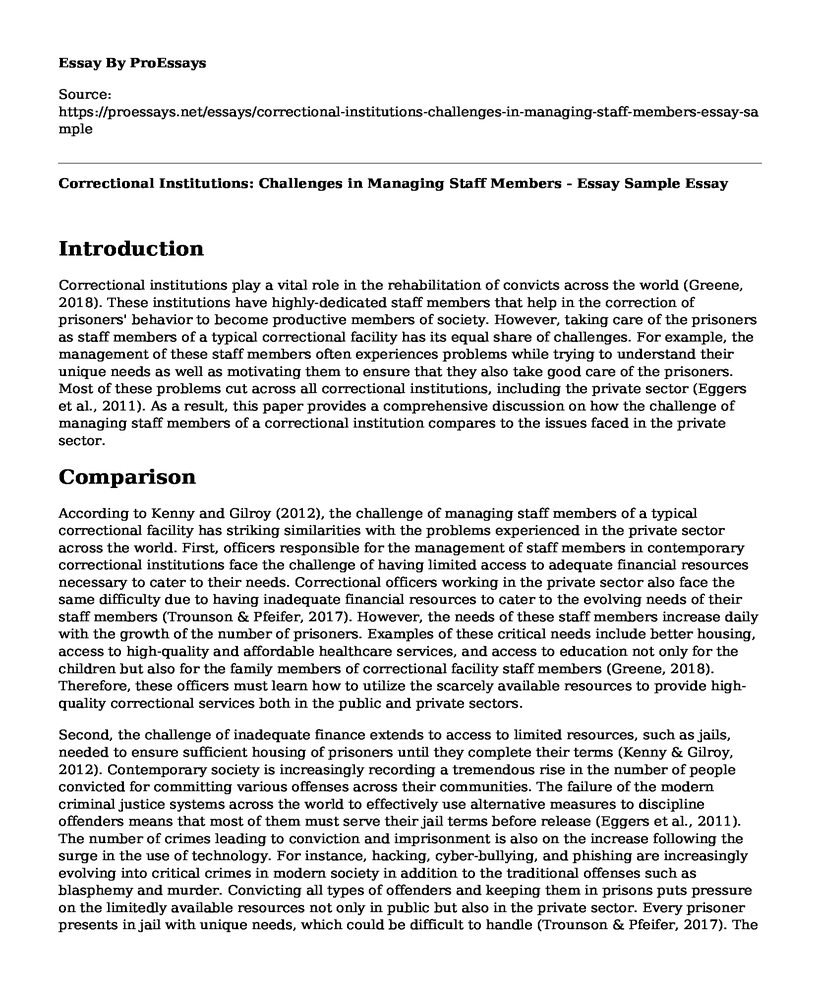Introduction
Correctional institutions play a vital role in the rehabilitation of convicts across the world (Greene, 2018). These institutions have highly-dedicated staff members that help in the correction of prisoners' behavior to become productive members of society. However, taking care of the prisoners as staff members of a typical correctional facility has its equal share of challenges. For example, the management of these staff members often experiences problems while trying to understand their unique needs as well as motivating them to ensure that they also take good care of the prisoners. Most of these problems cut across all correctional institutions, including the private sector (Eggers et al., 2011). As a result, this paper provides a comprehensive discussion on how the challenge of managing staff members of a correctional institution compares to the issues faced in the private sector.
Comparison
According to Kenny and Gilroy (2012), the challenge of managing staff members of a typical correctional facility has striking similarities with the problems experienced in the private sector across the world. First, officers responsible for the management of staff members in contemporary correctional institutions face the challenge of having limited access to adequate financial resources necessary to cater to their needs. Correctional officers working in the private sector also face the same difficulty due to having inadequate financial resources to cater to the evolving needs of their staff members (Trounson & Pfeifer, 2017). However, the needs of these staff members increase daily with the growth of the number of prisoners. Examples of these critical needs include better housing, access to high-quality and affordable healthcare services, and access to education not only for the children but also for the family members of correctional facility staff members (Greene, 2018). Therefore, these officers must learn how to utilize the scarcely available resources to provide high-quality correctional services both in the public and private sectors.
Second, the challenge of inadequate finance extends to access to limited resources, such as jails, needed to ensure sufficient housing of prisoners until they complete their terms (Kenny & Gilroy, 2012). Contemporary society is increasingly recording a tremendous rise in the number of people convicted for committing various offenses across their communities. The failure of the modern criminal justice systems across the world to effectively use alternative measures to discipline offenders means that most of them must serve their jail terms before release (Eggers et al., 2011). The number of crimes leading to conviction and imprisonment is also on the increase following the surge in the use of technology. For instance, hacking, cyber-bullying, and phishing are increasingly evolving into critical crimes in modern society in addition to the traditional offenses such as blasphemy and murder. Convicting all types of offenders and keeping them in prisons puts pressure on the limitedly available resources not only in public but also in the private sector. Every prisoner presents in jail with unique needs, which could be difficult to handle (Trounson & Pfeifer, 2017). The criminal system, therefore, transfers such challenges to the correctional officers.
Finally, disagreements among members of correctional facilities are also a critical challenge faced by their managers both in public and the private sectors (Greene, 2018). Staff members often disagree on working modalities due to the exhaustion that comes with managing congested jails with prisoners that present with unique needs. These disagreements usually culminate in disputes, which may hinder effective operations of the correctional institution as well as the private sector (Kenny & Gilroy, 2012). As a result, it is critical to have a detailed comprehension of the most vital management principle in the leadership of a typical jail to address these challenges and ensure smooth operations. Collaboration, which entails working with different stakeholders of the criminal justice system, including correctional officers, policymakers, and prisoners, can be the most vital management principle in prison leadership (Eggers et al., 2011). Managers of correctional facilities should ensure continuous cooperation and collaboration with their staff members not only to identify but also to address all the challenges faced in public as well as private sectors.
Conclusion
Correctional institutions remain vital facilities in the continuous development and sustainability of contemporary communities. Most of these correctional institutions have highly dedicated and committed officers who work to ensure that prisoners successfully serve their jail terms and eventually become productive members of their communities. However, officers working in these facilities face a plethora of challenges that highlight the need to develop appropriate counterstrategies not only in public but also in the private sectors. Using collaboration can be a valid principle of management that can contribute to operational sustainability in the long-run, as discussed in this paper.
References
Eggers, J. T., Porter, R. I., & Gray, J. W. (2011). Leading and managing those working and living in captive environments. US Army Research. 343(1), 273-290. https://digitalcommons.unl.edu/cgi/viewcontent.cgi?article=1342&context=usarmyresearch.
Greene, J. (2018). Comparing Private and Public Prison Services and Programs in Minnesota: Findings from Prisoner Interviews. Current Issues in Criminal Justice, 2(2), 1-45. https://www.inthepublicinterest.org/wp-content/uploads/Greene_Comparing-Private-and-Public-Prisons-in-MN.pdf.
Kenny, H. & Gilroy, L. (2012). The challenge of comparing public and private correctional costs. Reason Foundation. https://reason.org/wp-content/uploads/files/comparing_correctional_costs.pdf.
Trounson, J. S. & Pfeifer, J. E. (2017). Corrections officer wellbeing: Training challenges and opportunities. Practice: The New Zealand Corrections Journal, 5(1), 11-20. https://www.corrections.govt.nz/resources/research_and_statistics/journal/volume_5_issue_1_july_2017/corrections_officer_wellbeing_training_challenges_and_opportunities.
Cite this page
Correctional Institutions: Challenges in Managing Staff Members - Essay Sample. (2023, May 23). Retrieved from https://proessays.net/essays/correctional-institutions-challenges-in-managing-staff-members-essay-sample
If you are the original author of this essay and no longer wish to have it published on the ProEssays website, please click below to request its removal:
- Essay Example: Reason Against Prejudice New Immigrants
- Three Strike Law in Prisons: Alternatives, Effectiveness, Equity, Financial feasibility
- Paper Example on Strategies to Curb the Increased Crime Rate
- Falsely Accused/Racial Controversy - Research Paper
- Humans Rights Violations in Africa: Right to Education Paper Example
- Paper Example on Stigmatization of Jail Victims: 5-Year Evaluation Study
- Essay Example on No Nationality Required: Claim Human Rights Against State







